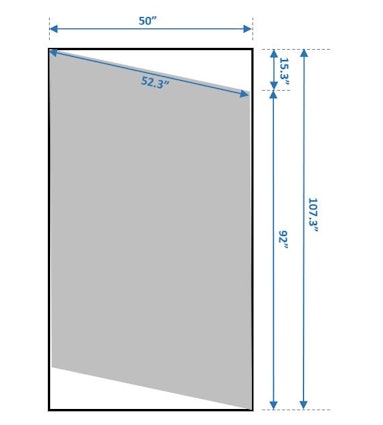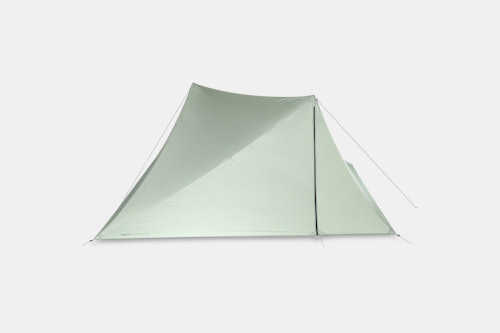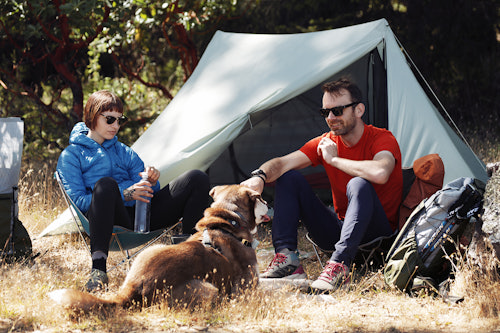Click to view our Accessibility Statement or contact us with accessibility-related questions
 VIEW 24 MORE
VIEW 24 MORE VIEW 10 MORE
VIEW 10 MORE VIEW 1 MORE
VIEW 1 MORE
 VIEW 10 MORE
VIEW 10 MORE
 VIEW 1 MORE
VIEW 1 MORE
Drop X-Mid 2P Tent Designed by Dan Durston
Drop X-Mid 2P Tent Designed by Dan Durston
bookmark_border
Where's the price?
To negotiate the best possible price for our customers, we agree to hide prices prior to logging in.
11.8K requests
·
Free Returns in USA
Product Description
Ultralight and easy to set up, the X-Mid 2P is our second collaboration with thru-hiker Dan Durston. With plenty of room for two, enjoying the great outdoors with a partner has never been easier.
Want to know something about this product or how to use it?
Ask the community!
Ask the community!
Sort by: Newest
keyboard_arrow_downProAlpine
51
Mar 21, 2020
This tent should be sub 2 lbs. If it's so revolutionary then why would I carry a 2 person, double tent that ways the same or more than all the others? Sorry, not going there.

dandurston
5118
Dan Durston
Mar 21, 2020
The X-Mid 2P is the lightest tent in it's class, but of course there are lighter classes of tents where you could give up substantial function/space/durability to save more weight.
You won't find lighter 2P tent that is also double wall, built of reasonably durable fabrics and has a decent amount of space. To go lighter, you have to buy a tent built with shorter lived materials (e.g 10D nylon), or a singlewall tent (a compromise in wet conditions) or a really small 2P tent. Where the X-Mid excels is at delivering the requisite functionality for a very capable tent at the lowest the weight. Instead of the classic formula of creating a ultralight tent by making an existing design smaller, lower performance or less durable, the X-Mid 2P saves weight through genuinely thoughtful design including the maximally efficient geometry (e.g. minimizing seams, optimal area:volume ratio, optimal pole placement etc). That means it might not be the lightest, but it is the most weight efficient (e.g. function for the weight). I would flip the question around and ask why other lighter tents might be "revolutionary" when they just take a traditional tent geometry and shrink it or gut the functionality for a splashy headline weight spec.
I'll illustrate the weight efficiency of the X-Mid by comparing with some other popular tents that are lighter. First is the "Two" by Gossamer Gear which is 8oz lighter at 28oz. That sounds great and I'm not picking on GG here - it's a nice tent - but it's only lighter because it makes major sacrifices to achieve that. It uses 10D fabric which is substantially lighter but also substantially less durable. The GG Two is also a singlewall so you're not protected from contacting condensation, and then it further skips having any vents, so you're more prone to getting condensation in a tent that doesn't protect you from it. It is also substantially smaller in all regards (length, width, height) and further skimps on the fabric coatings so the HH is much lower (our 2000mm spec is what the fabric tests at after extended wear so it is over 3500mm when new, whereas their 1200mm spec is for their new fabric which would test much lower after wear). Overall, the "Two" is appreciably lighter but there's no geometric innovation that achieved that. It's just the classic formula of taking a traditional tent shape (the A frame in this case) and making it less spacious, less functional and less durable. We could do that too but the X-Mid is intended to be a well rounded tent to excel in all 3 season conditions, while the "Two" is more of a tent for docile conditions.
As another example, MSR has their Carbon Reflex 2 at an impressive 27oz. That sounds amazing because unlike the GG Two, the CR2 is even a double wall. A hiker who doesn't look beyond the headline specs of "27oz/doublewall/2P tent" might think this blows the "36oz/doublewall/2P" X-Mid out of the water. But again there are major sacrifices in performance to achieve a weight like that. The CR2 is light because MSR is using very delicate fabrics (7D vs 20D) so the materials are far less durable. They've further skipped zippers on the fly and instead used clips that save a couple ounces but are widely criticized in reviews for blowing open, letting rain through, and being hard to use. Most notably though, it's light because it's an incredibly small tent for two: it's a full 10" lower inside (you can barely sit up 1 at a time). Then it further skips useful features like vents, plus goes ultra-minimal on the waterproof coatings which is why a leaking fly even when brand new is widely reported and acknowledged by MSR as a real problem (see here). All of that adds up to a tent that OutdoorGearLab says is "not suitable for three-season storms". So it is appreciably lighter but again it's not through clever innovation but just by sacrificing as much as it can. In doing so, it has become a niche tent for conditions where you hardly need a tent. The X-Mid also focuses on saving weight, but not at the expense of core functionality like keeping rain out. Unlike the CR2, X-Mid 2P has robust fabric coatings, fly first pitch, protected entry ways, no sag fabric, generous vestibules, ample space for two, more durable fabrics, proper zippers, peak vents, etc. You gain an enormous amount of performance and liveability for those extra 9oz. If you need a true 3 season tent, it's not even a comparison.
One last comparison is the Six Moon Design's Haven. The Haven is double wall, 2P, dual trekking pole tent. It's a nice tent and might get you asking why the X-Mid is special because the Haven looks sorta similar and weighs only 34oz instead of 36oz. However, that weight gap closes to about 1 oz when you consider the Haven needs seam sealing (it's not factory seam taped like the X-Mid) and it requires 2 more stakes So it's roughly 1 oz lighter and that's for a tent that is substantially narrower (44 vs 50" wide), shorter, and has a lot less headroom (because the poles aren't offset), plus it further saves weight through shorter lived #3 zippers like GG's The Two. I think it's remarkable that for only ~1 oz more, the X-Mid 2P offers a much larger space that is comfortable for two, more durable zippers, better vents, larger vestibules etc. The X-Mid 2P also has much better snow shedding performance (because the Haven has larger/flatter roof panels), simpler pitch, larger doorways, no sag poly fabric etc. On top of that it costs quite a bit less while using higher end materials and hardware like YKK AquaGuard zippers because there's a lot less markup on the X-Mid.
As these examples show, it's easy to make a tent light by making it smaller/limited function/less durable. Those tents often sell well because buyers look at the weight specs without considering what do you get for the weight and then end up disappointed in the field. Instead of looking only at the weight, I think it's best to consider what functionality you want to have in a tent, and then look for the tent that delivers that at the lowest weight. This won't be the absolute lightest tent, but it will be the most weight efficient tent (e.g. delivering the requisite function for the least weight). For anyone that needs a true 3-season tent with attributes like decent space, legit stormworthyness, reasonably durable materials etc, that answer is likely the X-Mid.
To illustrate how the X-Mid excels against tents that try to achieve this same aim, a much more comparable tent is the TarpTent StratoSpire 2. The SS2 is a highly regarded tent because it's a well rounded solid performing tent. It's a nicely sized tent for two, double wall, uses reasonable #5 zippers, durable fabrics, has vents etc. I've owned an SS2 and put hundreds of nights on it. It's a great, solid tent but still has some limitations like nylon fabric (sags when wet, absorbs a lot of water weight), tiny vents that are often crinkled shut from being packed, a complicated pitch, and corner struts which add weight and make it awkward to pack (e.g. won't store horizontally like the X-Mid). The total weight for this capable and well rounded tent is 42oz, so it's 6oz heavier and that's not considering you need to seam seal the SS2 and use more stakes so the actual weight difference is closer to 8oz (and then the nylon SS2 further gains more water weight in use). So the X-Mid is appreciably lighter while solving the main downsides of the SS2 (complicated pitch, hard to pack struts, ineffective vents, saggy nylon) plus it includes pockets inside the tent and comes factory seam taped (versus user seam seal). So you're getting at least as much function - arguably more - for a substantial 8oz less. Besides the function list, the X-Mid is a nicer to use tent because the poly fabric doesn't sag when wet (like nylon), it's a much simpler pitch, has one-handed zippers, and it can pack really short (stores horizontally in a pack).
How does the X-Mid deliver the most weight efficient tent? Through genuine innovation. It uses a unique and patent pending geometry that gives it a fundamentally more weight efficient shape and with fewer seams. It gets more volume from two poles by positioning them further apart and using a unique double diagonal design to make it all work inside a simpler rectangular fly shape. The superior area:volume ratio means less seams, less stress points to reinforce, and less fabric for the volume. Moving the poles further apart also gives steeper walls to solve the need for struts. It's a good (revolutionary?) design because it saves weight through novel engineering rather than chopping features, size and durability.
To wrap it up, we could easily get it sub 2 lbs if we shaved off useful features, used really delicate materials, and made it really small. That would look cool on a spreadsheet and would work well for some people, but I don't think it would be a better overall tent. The X-Mid is aimed at being high performance tent at the lowest weight, not just the lowest weight irrespective of performance. For people that are interested in a lightweight yet capable tent, I think it is a compelling design.
(Edited)

dandurston
5118
Dan Durston
Mar 17, 2020
Here's a diagram of the floor size to create a footprint.

https://ripstopbytheroll.com/collections/waterproof-polyester-fabric/products/1-6-oz-silpoly You would need 3 yards of that (108") although maybe 4 yards would be safer if you want extra for seam allowances. Cost would be about $20. Some further considerations are (1) you may want the groundsheet a tiny bit smaller than the floor if you want it to clip to the 4 corners and pull tight, and (2) you may want to make it larger if you're going to be folding the edges when sewing, and (3) the floor of the tent does vary somewhat with the pitch. The floor width isn't always 50" but can vary from 48 - 52" depends on how much you pull it upwards at the peaks.

https://ripstopbytheroll.com/collections/waterproof-polyester-fabric/products/1-6-oz-silpoly You would need 3 yards of that (108") although maybe 4 yards would be safer if you want extra for seam allowances. Cost would be about $20. Some further considerations are (1) you may want the groundsheet a tiny bit smaller than the floor if you want it to clip to the 4 corners and pull tight, and (2) you may want to make it larger if you're going to be folding the edges when sewing, and (3) the floor of the tent does vary somewhat with the pitch. The floor width isn't always 50" but can vary from 48 - 52" depends on how much you pull it upwards at the peaks.
(Edited)

dandurston
5118
Dan Durston
Mar 16, 2020
There is a pocket on the roof at each peak where you can insert a headlamp, and then also D rings inside each peak to hang a light or other items.

Birchlover
13
Apr 5, 2020
Is there a YT video of the tent fully guyed out? I saw one where DD explained a certain angle for the roof guylines, for example. I also see two loops at the bottom of the door, so I'm curious. Thanks so much.

dandurston
5118
Dan Durston
Apr 6, 2020
I have a pitching guide for the 1P on YouTube which is very similar:
https://youtu.be/cVboRcwY6P0?t=168
A difference though is that the ridgeline on the 1P isn't angled directly at the corner. It's pointed a bit off the end wall. If the ridgeline was equally support on both sides by the corner stakes then you'd just want to stake the peak guylines straight off the end of the ridgeline, but here the steeper corner by the door doesn't support it as well so you want to stake the peak guylines not directly off the ridgeline but towards the door to partially pull out on the ridgeline but also support this weaker side. You want to stake it a little further over than along the corner seem to equally balance the tent.


(Edited)

pblogic
27
Oct 2, 2020
Any chance of ever seeing a custom footprint from drop for this tent? I cut some polycryo for it, which is fine, but I'm just a sucker for a real, matching foot print.

dandurston
5118
Dan Durston
Oct 2, 2020
I've recently started working on this. Early stages, but hope to have one for spring.
EDIT: They are here:
https://durstongear.com/product/x-mid-1p-2p-groundsheet
(Edited)



